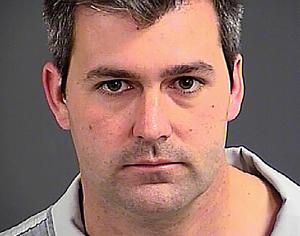CHARLESTON, S.C. (AP) — A white South Carolina police officer was charged with murder Tuesday, hours after law enforcement officials viewed a dramatic video that appears to show him shooting a fleeing black man several times in the back.
North Charleston Mayor Keith Summey announced the charges at a hastily called news conference in which he said City Patrolman Michael Thomas Slager made "a bad decision."
Saturday's shooting, which began as a traffic stop over a faulty brake light, occurred as Americans grapple with issues of trust between law enforcement and minority communities after a series of deaths of unarmed black men at the hands of police. They include the deaths of Michael Brown in Ferguson, Missouri, and Eric Garner on Staten Island, New York. Both sparked protests nationwide.
In the Charleston case, authorities said the victim, 50-year-old Walter Lamer Scott, was shot after the officer already hit him with a stun gun.
"When you're wrong, you're wrong," Summey said. "When you make a bad decision, don't care if you're behind the shield or a citizen on the street, you have to live with that decision."
A video of the shooting released to news media outlets shows the officer firing eight shots at Scott's back as Scott is running away. Scott falls on the eighth shot, fired after a brief pause. The video then shows the officer slowly walking toward him, and ordering him to put his hands behind his back.
When Scott doesn't move, Slager pulls his arms back and cuffs his hands. Then he walks briskly back to where he fired the shots, picks up an object, and returns the 30 feet or so back to Scott before dropping the object by Scott's feet.
Slager's then-attorney David Aylor had released a statement Monday saying the officer felt threatened and that Scott was trying to grab Slager's stun gun. Aylor dropped Slager as a client after the video surfaced.
View gallery

North Charleston police officer Michael Slager is seen in an undated photo released by the Charlesto …
Attorney L. Chris Stewart, who came to North Charleston a day after the shooting to represent the family, said the video forced authorities to act quickly and decisively, and he called the person who made the video a hero.
"What happened today doesn't happen all the time," Stewart told a news conference. What if there was no video?" Scott's mother stood nearby, saying, "Thank you, Lord" and "Hallelujah."
Scott may have tried to run from the officer because he owed child support, which can get someone sent to jail in South Carolina until they pay it back, Stewart said. He had four children, was engaged and had been honorably discharged from the U.S. Coast Guard. There were no violent offenses on his record, the attorney said. Stewart said the family plans to sue the police department.
Justice Department spokeswoman Dena Iverson said the Federal Bureau of Investigation will also investigate the shooting.
At the earlier news conference with the mayor, North Charleston Police Chief Eddie Driggers appeared close to tears.
"I have been around this police department a long time and all the officers on this force, the men and women, are like my children," he told reporters. "So you tell me how a father would react seeing his child do something? I'll let you answer that yourself."
Slager was denied bond at a brief first appearance hearing Tuesday. He was not accompanied by a lawyer. If convicted, he could face 30 years to life in prison. Slager also served in the United States Coast Guard and had been with North Charleston police for five years.
North Charleston is South Carolina's third-largest city and for years battled back from an economic slump caused by the closing of the Charleston Naval Base on the city's waterfront in the mid-1990s.
But now the city has bounced back in a big way, largely in part to the huge investment by Boeing, which has a 787 aircraft manufacturing plant in the city and employs about 7,500 people in South Carolina, most of them in North Charleston.
The shooting occurred as heightened scrutiny is being placed on police officer shootings, particularly those that involve white officers and unarmed black suspects. A grand jury declined to indict Ferguson, Missouri, officer Darren Wilson in the fatal shooting of Brown last August, leading to nationwide protests.
In a separate case in South Carolina, a white police officer who shot a 68-year-old black man to death last year in his driveway was charged Tuesday with a felony: discharging a gun into an occupied vehicle. A prosecutor previously tried to indict North Augusta officer Justin Craven on a manslaughter charge in the February 2014 death of Ernest Satterwhite. But a grand jury instead chose misconduct in office, which is a far lesser charge.
Craven chased Satterwhite for 9 miles beyond city limits to the man's driveway in Edgefield County. After Satterwhite parked, the officer repeatedly fired through the driver-side door, prosecutors said. The 25-year-old officer faces up to 10 years in prison if convicted of the gun charge.
_____
Associated Press writers Jeffrey Collins in Columbia, S.C., and Tom Foreman Jr. in Charlotte, N.C., contributed to this report.